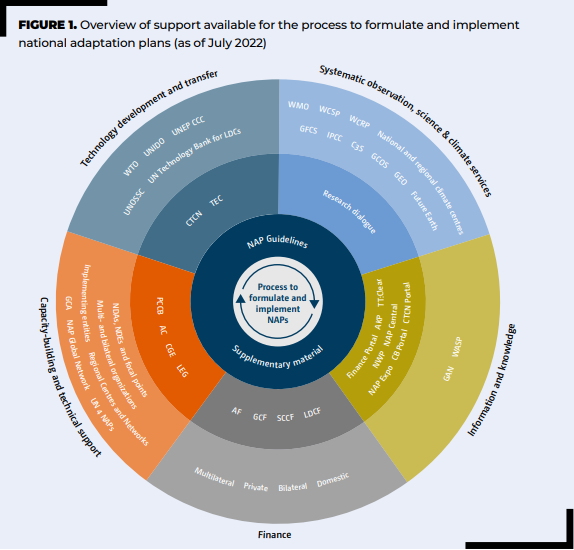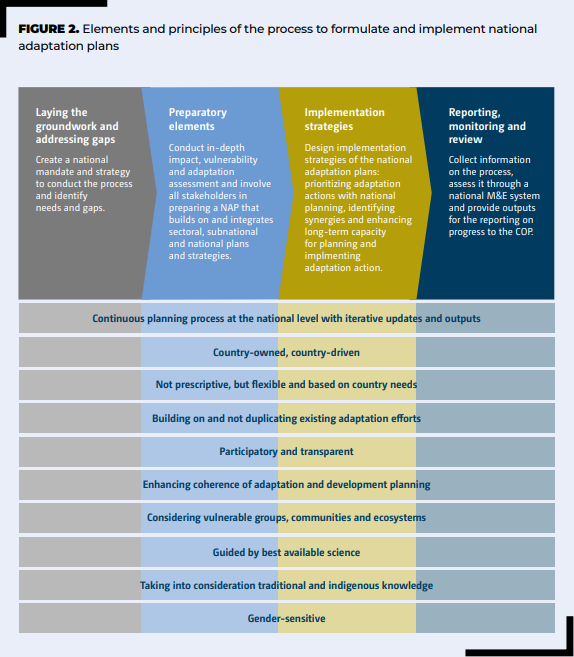Navigating the landscape of support for the process to formulate and implement national adaptation plans. 2022 Overview

Abstract
This publication provides an overiew of the landscape of support available for adaptation and of the targeted programmes andinitiatives that have been set up to facilitate the formulation and implementation of NAPs. It is structured around six different categories of support: “Guidelines”, “Systematic observation, science and climate services”, “Information and knowledge”, “Finance”, “Capacity-building and technical support”, and “Technology development and transfer”. It updates and complements the information contained in the Adaptation Committee’s report on Navigating the landscape of support for the process to formulate and implement national adaptation plans published in 2015.
As the support needs of different countries at different stages of the process to formulate and implement NAPs vary and will continue to evolve, the landscape of available support will also adapt to those needs. In light of the dynamic nature of the provided support, this publication is complemented by an online information source on which the information on available support will be updated more frequently and more flexibly. The online information source is available at unfccc.int/napsupport.
Introduction
In 2010, the COP of the UNFCCC established the process to formulate and implement national adaptation plans with the objectives to reduce countries’ vulnerability to the impacts of climate change and to facilitate the integration of climate change adaptation into relevant new and existing policies, programmes and activities. It is a continuous and progressive process that shall enable countries to identify medium- and long-term adaptation needs and to develop and implement – in a coherent, iterative and country-driven manner – strategies and programmes to address those needs. NAPs also help countries strengthen the adaptation-related elements of their nationally determined contributions as part of the implementation of the Paris Agreement.
Mindful of the financial, technical and capacity needs of the developing countries to formulate and implement NAPs, the COP has mandated and called for a broad range of support from developed country Parties, constituted bodies under the Convention, the operating entities of the Financial Mechanism of the Convention and the Paris Agreement and national and regional centres and networks as well as from UN organizations, specialized agencies, bilateral and multilateral agencies and other relevant organizations.
In parallel, several targeted support programmes and initiatives have been established to specifically support the developing countries in formulating and implementing their NAPs and other existing adaptation support mechanisms have aligned their processes and portfolios with the same objective. Furthermore, countries can tap into the vast overall landscape of support that is available for the different aspects of adaptation planning and implementation in accordance with their individual needs.
This publication provides an overview of the landscape of support available for adaptation and of the targeted programmes and initiatives that have been set up to facilitate the formulation and implementation of NAPs.
This article is an abridged version of the original text, which can be downloaded from the right-hand column. Please access the original text for more detail, research purposes, full references, or to quote text.

The landscape of support available for the process to formulate and implement national adaptation plans
Support for the process to formulate and implement NAPs is provided in response to specific mandates and provisions under the Convention and the Paris Agreement as well as by domestic, bilateral, multilateral and private institutions and actors that provide NAP and adaptation-relevant assistance outside the scope of these provisions. The support is available in the form of guidelines; systematic observation, science and climate services; the provision and sharing of information and knowledge; finance; capacity-building and technical support; and technology development and transfer (figure 1). Despite being described in distinct sections in this publication, many of the categories of support overlap. As a result, many of the entities described under one category of support in reality provide several types of support in parallel.

Guidelines for the process to formulate and implement NAPs
In 2011 the COP agreed on the initial guidelines for the formulation of NAPs which structure the process into four elements:
- Laying the groundwork and addressing gaps;
- Preparatory elements; c. Implementation strategies;
- Reporting, monitoring and review. Together with the guiding principles defined by the COP, these four elements provide an overall framing of the formulation and implementation of NAPs.

Concluding remarks
The process to formulate and implement national adaptation plans is the key instrument in enabling countries to address their medium- and long-term adaptation needs in a coherent and strategic manner. Commensurate with the magnitude of the process the support needs of developing countries are immense. At the same time, the landscape of support available to them has greatly expanded over the years and counts with an extensive number of opportunities in all areas of support. Through this report the Adaptation Committee has made an effort of providing a broad overview of such opportunities and will keep updating the information as countries’ needs and the available support continue to evolve.

(0) Comments
There is no content